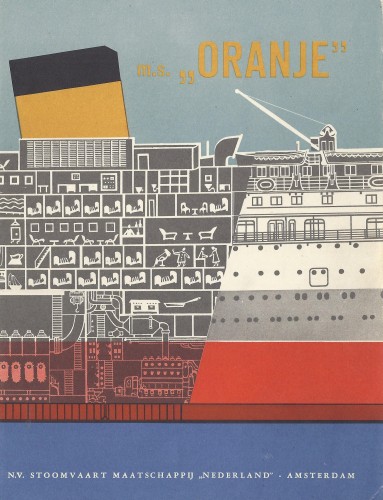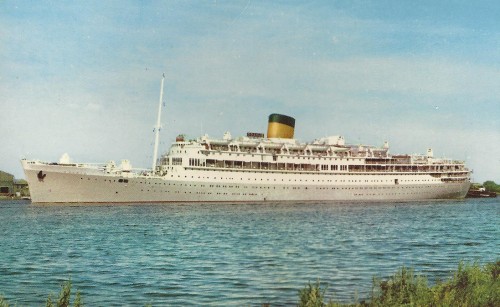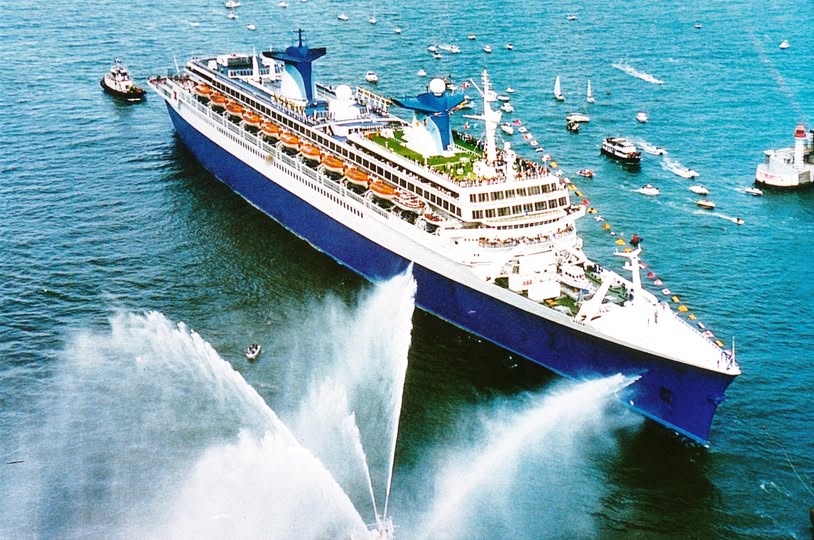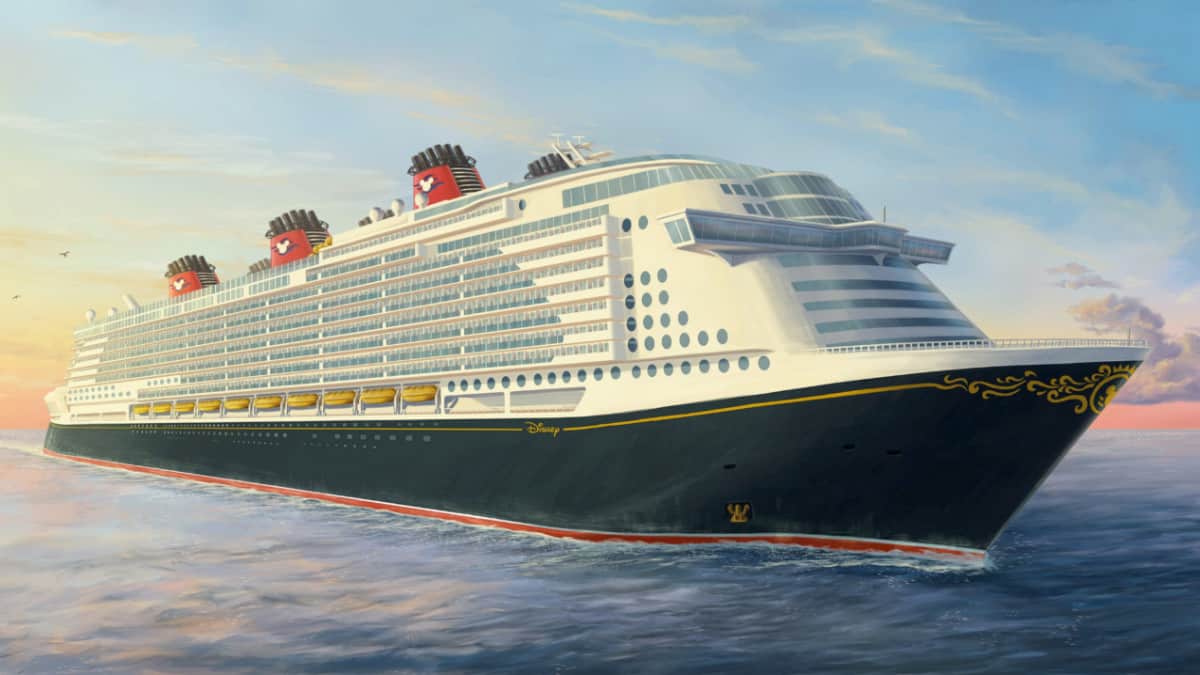In the mid-thirties, The Netherland Line (Stoomvaart Matschappij Nederland in Dutch) being in need of additional tonnage for their lucrative service to the Dutch West Indies alongside their much loved Johan van Oldebarnevelt (1929), ordered a newbuilding from the Netherlands Shipbuilding Cy. in Amsterdam. Construction started on July 2, 1937 with the keel laying ceremony. She was the first large passenger ship built in the Netherlands after the economic depression of the 1930’s and was designed by naval architect Huibert Nicolaas Prins who had worked on several vessels for the Netherlands Line, both liners and freighters in the 1920’s and 30’s. Unfortunately he died just before his masterpiece departed on her maiden voyage. On the day of her launch, September 8, 1938, 20.000 spectators and an armada of boats saw HRH queen Wilhelmina arrive in the Royal Sloop. The Dutch war ship Hr Ms Tromp fired 101 salutes. HRH queen Wilhelmina named her Oranje, naming her coincided with the anniversary of her 40 year reign of the Netherlands. The new Netherlands Line flagship was named after the Dutch Royal House of Orange. There was a problem during the launch ceremony however. After the queen had activated the mechanism that actually would free the vessel and send her down the slipway, nothing happened! Yard workers worked frantically for over an hour and when she finally did slide majestically down the slipway, the Queen spoke the famous words: “She is a real member of the house of Orange, we are all quite rigid…”.

Oranje was a medium sized vessel, some specs: she measured 20,117 GRT, was 200 meters long, 25 meters wide, her draft was almost 9 meters and with a crew of 383 she carried 740 passengers in four classes, 283 first, 283 second, 92 third and 82 fourth class on 8 decks. Normally Dutch liners didn’t have a reputation for speed, but Oranje was the fastest diesel powered passenger liner of her day. With her 3 x 12 cylinder Sulzer diesels 37,500 hp (27,964 kW), she could reach an astonishing 26.5 knots meaning that she could reach the Dutch West Indies in 3 instead of the usual 4 weeks. She was also known for her tumblehome hull, meaning that her hull was wider at waterline level than upwards, it sloped inwards towards her top decks. The difference in width was over 5 meters! It was said that being designed this way gave her greater speed and better handling at sea, having improved stability, but the real reason was the need for enough space to install th three massive diesel engines at and just below waterline level while the upper decks could be significantly smaller because the Netherlands line wanted only outside cabins here. The fact that this saved in gross tonnage and also Suez Canal fees was a welcome extra. The people of the Dutch West Indies nicknamed her Kapal Boenting, the pregnant ship.


With fitting out and sea trials completed Oranje was handed over to the Netherland Line on June 27, 1939. After two introductory cruises to Madeira and the Azores, she left on her intended route to the Dutch West Indies. Her service was cut short however as at the end of her final voyage, World War II had started. From December 1939 until February 1941 she was laid up in Surabaya, Dutch West Indies. Netherland Line did not want her to return to Amsterdam because they feared sea mines in the North Sea would possibly sink her. The Dutch handed her over to the Autralian Navy and she was converted to a hospital ship, the Dutch paying for the conversion costs. Oranje was one of seven Dutch liners serving as hospital ships during WWII.

She emerged with a white hull and and green band which was interrupted by red crosses. Oranje was still manned by a Dutch crew although she sailed under Australian command. For the next five years, based in Australia, she sailed on 41 voyages into the Pacific, Asia, Middle East and North Africa caring for over 32,000 wounded Australian, New-Zealand and British soldiers. In November 1945 she returned home to Amsterdam where she received an impressive welcome. It took 6 months of refitting to have her return to liner service. After the war she repatriated thousands from Indonesia back to the Netherlands for the first year being chartered by the Dutch government. At the start her sailings ended in Southampton instead of Amsterdam as the sea locks of IJmuiden had been severely damaged during the war, after repairs were finished she continued on to Amsterdam. Her regular commercial service for the Netherland Line on the familiar route from Amsterdam to the Dutch West Indies recommenced in 1947.

During her last years of sailing for the Netherland Line, Oranje made news headlines twice. The first time this happend it was because of her collision with the Rotterdam Lloyd flagship Willem Ruys in the early morning of January 6, 1953. When they would meet at sea, it was customary that both ships would greet each other passing at short distance. This was always a great moment for passengers on both ships. Because of a misunderstanding things went horribly wrong and Oranje and Willem Ruys ended up colliding in mid ocean. I have described this event in greater detail in my article on the Willem Ruys. The second time she got into the news was when she hosted the celebrations of the 25-year marriage of HRH queen Juliana and HRH prince Bernhard and was absolutely crowded with royalty! Her sailings to the former Dutch West Indies ended in 1958 as the former Dutch colonies had become officially independent since 1949 and over time relations between the Netherlands and the state of Indonesia had not improved to put it mildly and Indonesia now made it all too clear that Dutch liners were not welcome anymore. So alternative employment had to be found for Oranje. In 1958/59 Netherlands Line gave her an extensive refit, mainly redecorating her interiors. When she re-emerged she could carry 323 first and 626 tourist class passengers replacing her former 4-class configuration. Her decks had been extended aft and a new cinema had been added midships. Her new employment would be on a round the world service together with fleetmate Johan van Olderbarnevelt and the Rotterdam Lloyd Willem Ruys, under the banner of the Royal Dutch Mail Ships.

She now departed Amsterdam via Southampton, the Suez Canal, Singapore to Australia and New Zealand, the Panama Canal, Port Everglades, Bermuda, Southampton again before returning to Amsterdam. Three years later, in 1960 it became clear that on this route also, the passenger liner was losing the battle with the aeroplane which saved travellers so much time and passenger loads plummeted. Between 1958 and 1964 Oranje had made several “test-cruises” in European waters to determine if cruising could be an alternative for her, but they were not a great financial success. And so the Netherland Line came to the inevitable conclusion: Oranje would be withdrawn and offered for sale.

Ultimately, after a brief period of lay up she was sold to Flotta Lauro, an Italian shipping company. The immediately sent her to the Cantieri Navali del Tirreno Riuniti shipyard in Genoa to be extensively rebuilt. She was renamed Angelina Lauro and emerged with a modern, more streamlined profile and a large, much higher funnel with a smoke deflector. Lauro also bought the Willem Ruys which they also completely rebuilt and renamed Achille Lauro (see my article on Achille Lauro).

Lauro planned both ships would sail in cruise service and on the familiar route from Europe to Australia, as their Roma and Sydney were quite small and so capacity would be boosted. After her refit, Angelina Lauro’s Promenade deck had been extended forward and was now entirely glazed in. Also, her aft decks had been extended. A new raked bow added 5 meters to her length, while her new funnel was fitted with louvres around it which obviously was a nod to Italy’s well-known liners Michelangelo and Raffello whose funnels were famous for their lattice-work casings. Her interior was redone Italian style and her hull was now painted blue with a white stripe. When she was almost ready for delivery, Angelina Lauro was partly destroyed by fire, which killed 6 shipyard workers. March 1966, she was finally back in service on the Europe – Australia – New Zealand route via the Suez Canal and back. The Suez Canal was closed by Egypt from 1965, the beginning of the Six Day War until 1975 forcing her to sail around the Cape of Good Hope. Her service to Australia and New Zealand lasted until the beginning of the seventies, as the jet airliners had now completely taken over and liner service was no longer economically viable. Lauro had her refitted again, this time she was converted to an 800 passenger one class full time cruise ship in 1972.

Cruises were planned in the Caribbean out of San Juan which were marketed by another Italian cruise line, Costa Line. Costa, when Angelina Lauro’s cruises proved popular, decided to charter her beginning October 1977 for Caribbean cruise service out of Port Everglades. She was not renamed, only her funnel was repainted in Costa-yellow with the letter “C” on its sides. Port of the year she would relocate to Europe and sail positioning cruises in between. All went well until March 1979 when disaster struck. She was berthed in St. Thomas, US Virgin Islands, when a fire broke out in the crew galley aft and quickly spread forward through passenger spaces. Luckily, her passengers were ashore at this time and the remaining crew could evacuate Angelina Lauro in time. Her hull soon filled up with water firefighters had pumped into her and she settled on the harbour bottom listing to port.

The completely destroyed ship was soon declared a complete total loss and stayed dockside for three months before a German salvage company succeeded in refloating her in July 1979. Sold to Taiwanese breakers, she was towed through the Panama Canal and into the Pacific where in mid-ocean with deteriorating weather her hull plating which had been damaged by the fire started to give way and she started to take on water.

In the course of the following four days she listed until she was completely on her side. Finally, in the early morning of September 24, 1979 she disappeared below the waves, a sad end to a much loved ship, especially by the Dutch as the former Oranje is one of their most iconic passenger ships, amidst the Willem Ruys, Nieuw Amsterdam and the Rotterdam V. As I described in the Willem Ruys/ Achille Lauro story Achille Lauro would meet the same fate as the Angelina Lauro when she burned off the coast of Somalia in 1994 and sank….



